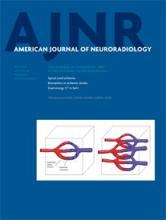Abstract
BACKGROUND AND PURPOSE: Familial cerebral cavernous malformations, an autosomal dominant disorder, result in excess morbidity and mortality in affected patients. The disorder is most prevalent in the Southwest United States, where the affected families are most often carriers of the CCM1-KRIT1 Common Hispanic Mutation. The brain and spinal cord parenchyma in these individuals is usually affected by multiple cavernous malformations. Previous studies have shown abnormalities of endothelial cell junctions and the blood-brain barrier in cerebral cavernous malformations. Endothelial cell abnormalities have also been described in pathologic studies of white matter hyperintensities. We compared the prevalence of white matter hyperintensities in a population with known familial cerebral cavernous malformations.
MATERIALS AND METHODS: We examined 191 subjects with familial cerebral cavernous malformations who were enrolled into an institutional review board–approved study. All carry the same Common Hispanic Mutation in the CCM1 gene. Each subject underwent 3T MR imaging, including gradient recalled-echo, SWI, and FLAIR sequences. The number of cavernous malformations and the number of nonhemorrhagic white matter hyperintensities were counted. Subjects older than 60 years of age were excluded due to the high prevalence of white matter lesions in this population, and children younger than 6 were excluded due to potential sedation requirements. Logistic regression analysis was performed to determine the prevalence of abnormal white matter hyperintensities in those with familial cerebral cavernous malformations compared with healthy controls or those with sporadic cerebral cavernous malformation within the familial cerebral cavernous malformations group; it was also performed to evaluate the associations between abnormal white matter hyperintensities and age, sex, headaches, thyroid disease, diabetes, hypertension, hyperlipidemia, seizure history, or modified Rankin Scale score.
RESULTS: Familial CCM1 carriers have a higher prevalence of abnormal white matter hyperintensities (15.4%) compared with both control populations (2.1% and 2.5%, respectively) (P < .05). Logistic regression showed no statistical association with sex, headaches, hyperlipidemia, hypertension, thyroid disease, seizure history, number of cerebral cavernous malformations, or modified Rankin Scale score among those with familial cerebral cavernous malformation. An expected correlation with age was shown.
CONCLUSIONS: Familial CCM1 carriers have not only an increased number of cerebral cavernous malformations but also an increased number of white matter T2 hyperintensities, spatially distinct from cerebral cavernous malformations, which exceeded that of a healthy population. Clinical findings did not explain the association with abnormal white matter hyperintensities in the familial cerebral cavernous malformation population. To our knowledge, these relationships have not been previously reported. This finding suggests an additional manifestation of endothelial abnormalities in this population.
ABBREVIATIONS:
- CCM
- cerebral cavernous malformation
- fCCM
- familial cerebral cavernous malformations
- WMHI
- white matter hyperintensities
- © 2015 by American Journal of Neuroradiology
Indicates open access to non-subscribers at www.ajnr.org












